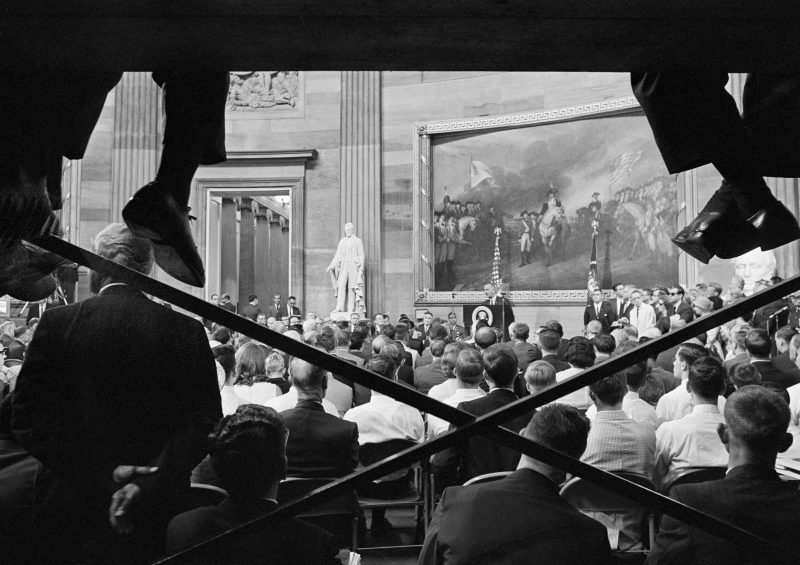There may be no person in these United States who likes polling more than CNN’s Ariel Edwards-Levy. Polling is part of her job at the cable news channel, so that’s not entirely surprising. But Edwards-Levy also likes to spend free time perusing the archive of historic polling data collected by Cornell University’s Roper Center.
On occasion, then, Edwards-Levy drops something like this in her Twitter feed:
things that could happen in 1985, according to 1965 pollsters:
-dramatic increases in standard of living
-major scientific and medical advances
-world peace
-collapse of civilization
-uh, some ladies not wearing a top? pic.twitter.com/gSaC0Gs1lu
— Ariel Edwards-Levy (@aedwardslevy) June 1, 2023
That list is hard to read, admittedly, but we will get to it in a moment.
What’s shown is a subset of the full Gallup poll, a survey that contains the items that Edwards-Levy describes, including the one about the state of undress on America’s beaches. That alone is a useful reminder for what we’re considering here.
This was 1965, five years after the release of the deeply corny song “Itsy Bitsy Teenie Weenie Yellow Polka Dot Bikini.” In Slate’s 2006 history of the bikini, Julia Turner notes that the swimwear item had become near-universal by 1965, with the Sports Illustrated swimsuit issue debuting the year before.
This wasn’t just a new development; it was a rapid change from what came before. Post-World War II, post-1945 America was different. The country was confident, powerful, expansive. The baby boom had just ended in 1965 and the Cold War was in full swing. So why, if the United States had suddenly embraced two-piece bathing suits for women, might people not expect further changes in another 20 years?
So Gallup presented a range of speculative things that might occur within the next 20 years, from curing cancer to the collapse of Russia to the collapse of civilization entirely. In almost every case, less than half of Americans thought Gallup’s speculative 1985 developments would occur; in almost every case, more respondents said the possible future wouldn’t occur than said it would.
The development about which Americans felt most optimistic was that scientists would discover a cure for cancer by 1985. More than three-quarters said this would happen which, of course, it didn’t.
Optimism on this front wasn’t unwarranted. The medical and scientific communities, like other technologically oriented pursuits, saw an enormous array of achievements in the early part of the 20th century. The possible future offered by Gallup that Americans were third-most likely to see coming true was that the common cold would be cured.
Only one of the possible futures outlined by Gallup actually did occur by 1985: American astronauts set foot on the moon. This was a pledge from President John F. Kennedy a few years before, and Americans clearly believed him. Here, too, there was a track record of accomplishment to which people could point, including John Glenn’s successfully orbiting the Earth a few years previously.
Americans were less optimistic about Johnson’s ability to win the War on Poverty he’d declared in his 1964 State of the Union address. It was among the possible accomplishments Americans thought were least likely to be achieved. While poverty was reduced, it was certainly not eradicated.
Some of the questions offered by Gallup were simply too narrowly constrained by time. Russia — that is, the Soviet Union — did reject communism, but not until a few years after 1985. Fewer people thought that would occur by 1985 than that the United States itself would shift to a socialist economy.
There are two ways to look at the success respondents had in predicting what would or wouldn’t happen over the next 20 years. One is that they were wise, recognizing Gallup’s extensions of current trends as unlikely to actually occur. The other is that they were pessimistic, assuming that the future would look a lot like the present.
It’s interesting to consider what actually unfolded over the next 20 years: the election of Richard M. Nixon and his resignation, the stagnation of the once-booming economy, the emergence of Ronald Reagan. And that’s mostly just politics, leaving out things like personal computers.
Predicting the future is hard, as the people developing Gallup’s poll questions could attest. Some things would change dramatically over a 20-year period, but figuring out which is tricky.
Imagine asking someone in 2003 what might occur by 2023. The election of Donald Trump? The pandemic? The dominance of social media? The Capitol riot? Only one of those things was foreseeable in 2013.
The only way to really know what the future holds is to wait.



























